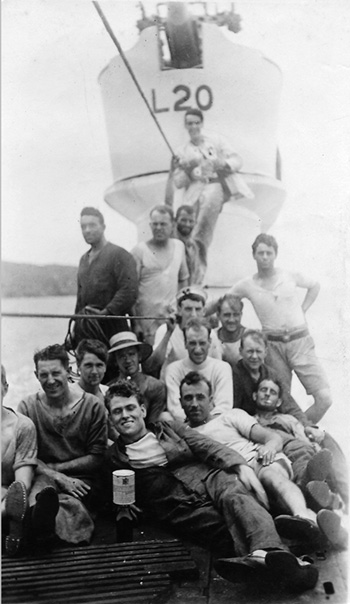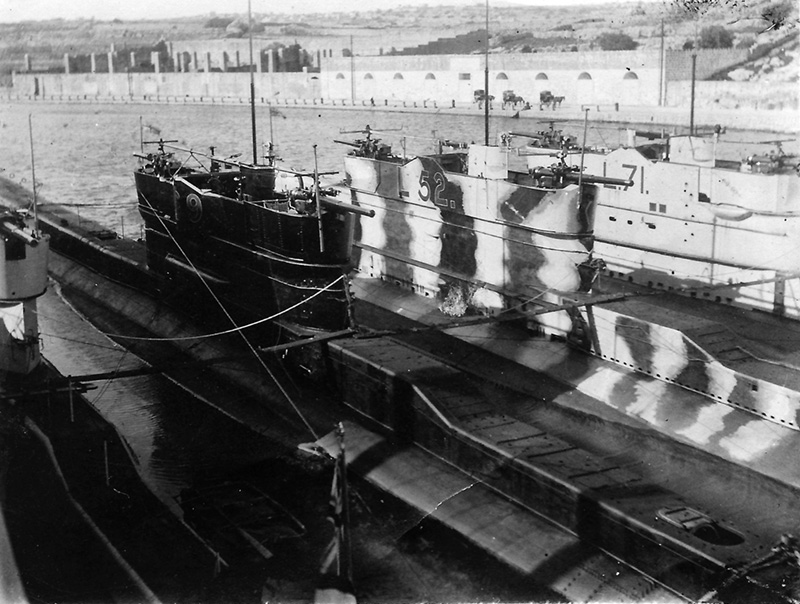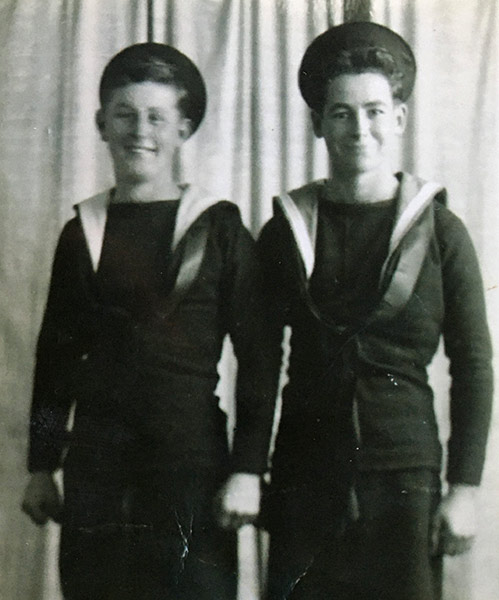
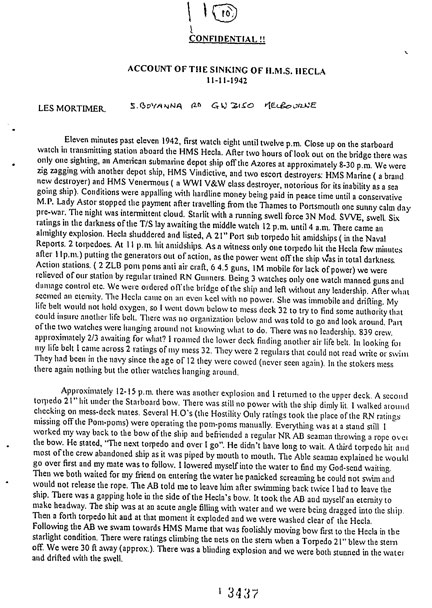 Left:
Left: A studio portrait of Leslie Mortimer and friend soon after joining the Navy in December 1941
Right: The first page of his typed description of the sinking of HMS
Hecla and his rescue by HMS
Venomous on 12 November 1942
Eleven
minutes past eleven 1942, first watch eight until twelve p.m. Close up
on the starboard watch in the transmitting station aboard the HMS
Hecla.
After two hours as lookout on the bridge there was only one
sighting, an American submarine depot ship off the Azores at
approximately 8.30 p.m. We were zig zagging with another depot ship,
HMS
Vindictive, and two escort destroyers: HMS
Maine (a brand new destroyer) and HMS
Venomous (a
WWI V&W class destroyer, notorious for its inability as a sea going
ship). Conditions were appalling with hardlying money being paid in
peace time until a conservative M.P. Lady Astor stopped the payment
after travelling from the Thames to Portsmouth one sunny calm day
pre-war. The night was intermittent cloud. Starlit with running swell
force 3N Mod. SVVE, swell. Six ratings in the darkness of the T/S lay
awaiting the middle watch, 12 p.m. until 4 a.m. There came an almighty
explosion.
Hecla shuddered
and listed, a 21” port sub torpedo hit amidships (in the Navel reports
2 torpedoes, At 11 p.m. hit amidships. As a witness only one torpedo
hit the
Hecla a few minutes
after 11 p.m. putting the generators out of action, as the power went
off the ship. The ship was in total darkness. Action stations. (2 ZLB
pom-pom anti-aircraft, 6 x 4.5 guns, immobile for lack of power) We
were relieved of our station by regular trained RN Gunners. Being 3
watches only one watch manned guns and damage control etc. We were
ordered off the bridge of the ship and left without leadership. After
what seemed an eternity. The Hecla came on an even keel with no power.
She was immobile and drifting. My lifebelt would not hold oxygen, so I
went down below to mess deck 32 to try to find some authority that
could insure another life belt. There was no organisation below and I
was told to go and look around. Parts of the two watches were hanging
around not knowing what to do. There was no leadership. 839 crew
approximately 2/3 waiting for what? I roamed the lower deck finding
another air life belt. In looking for my life belt I came across 2
ratings of my mess 32. They were two regulars that could not read,
write or swim. They had been in the navy since the age of twelve. They
were cowed (never seen again). In the stokers mess there again were
nothing but the other watches hanging around.
At about 12.15 p.m. there was another explosion and I returned to
the upper deck. A second torpedo 21” hit under the starboard bow. There
was still no power with the ship dimly lit. I walked around checking on
mess deck mates. Several H.O’s (Hostility Only ratings) took the
place of the RN ratings missing from the pom-poms, operating the
pom poms manually. Everything was at a stand-still. I worked my way
back to the bow of the ship and befriended a regular Navy Able Seeaman
(AB)
throwing a rope off the bow. He stated “The next torpedo and over I
go.” He didn’t have long to wait. A third torpedo hit and most of the
crew abandoned ship as ithe command was peassd by word of mouth. The
Able Seaman said he would go over first and my mate was to follow. I
lowered
myself into the water to find my God-send waiting. Then we waited for
my friend to enter the water. He panicked screaming he could
not swim and would not release the rope. The AB told me to leave him
after swimming back twice. I had to get away from the ship. There was a
gapping
hole in the side of the Hecla’s bow. It took the AB and myself an
eternity to make headway. The ship was at an acute angle filling with
water and we were being dragged back into the ship. Then a forth
torpedo hit
and exploded and we were washed clear of the
Hecla. Following the AB we swam towards HMS
Marne, which was foolishly moving bow first to the
Hecla
in the starlight conditions. There were ratings climbing the nets on
the stern when a 21” torpedo blew the stern off. We were approximately
30 foot away. There was a blinding explosion and we were both stunned
and drifted with the swell.
After returning to my senses the AB said “We should leave the
Marne" and we swam away into the rolling swell. We thought the
Marne had had it. Then there came a fifth explosion in the direction of the
Hecla.
The water was alive with men hold ing onto debris and smashed life boats. We
swam into the swell again, coming from a northern direction. We came
across what looked like a sub’. Stopping we listened to voices calling
for the name of the ship in an American accent. I suggested going along
side but the Able Seaman said we were to get away as it would be
dangerous. We turned and swam in the opposite direction. We were
confronted with what turned out the be HMS
Venomous depth charging the area (the sub was attacking – surfaced).
Venomous was
depth charging amongst the survivors. Several floats crowded with
survivors came by but it was impossible to get a hold (oil was
everywhere). We carried on into the night. How long we swam could not
be recorded but the
Venomous
came into view, stopping to pick up a float full of men. She misjudged,
hitting the float and spilling the men to either sides of the ship. We
swam to the nets of the
Venomous on the stern and hung on being extremely exhausted. There came a voice from the bridge shouting “Let go AFT I have a ping”
Veromous
took off dragging us in the net. How long I was in the net I don’t know.
After screaming out I was untangled, dragged on board and thrown on the
deck. Afterwards thrown into the hammock rack in the seamen’s mess
deck to recuperate. When I came to I found myself lying alongside the
seaman friend that had refused to let go of the rope on the
Hecla.
He was raving mad. No one could do anything for him. We were told to
leave him he would recuperate. At first light I was helping to clean up
the mess on the quarter-deck near the nets when they pulled a body out
of the nets. It was the able seaman I had spent the night with. The
Venomous had something to answer for.
After picking up more men
Venomous became short of fuel and went along side of HMS
Marne with her stern blown off and milked for fuel. She then left the
Marne
and proceeded to Casablanca hoping Casablanca had been taken from the
Vichy French during ‘Operation Torch” North Africa. The reason for
going to Casablanca was that
Venomous hadn’t enough fuel to get to Gibraltar.
Venomous
at 12 knots stanchions cracked like B-gun firing. How men could take
such conditions is hard to understand. Water washed over the bows and
tore aft and into the seaman’s mess deck. Everything was wringing wet.
Her full speed 17 knots would have been a nightmare. We approached
Casablanca cautiously and a signal with authorities told us the
American’s had landed and were mopping up. We approached slowly to find
three USS ships, the flag ship of the American Med fleet USS
Augusta and aircraft carrier USS
Guadalcanal and a destroyer with a gapping hole in the bows. Tying up alongside to refuel the
Venomous
was invited to dine and everyone kitted up with clothing. Lunch, dinner
and breakfast. Then off to Gibraltar where we were invited into the
harbour and put aboard the battleship
King George V during the whole of the action I cannot remember seeing one officer. Not anyone above a petty officer.
The following day we were transferred to the
Stratheden, a liner, and put below with one officer off the
Hecla.
Below deck conditions were degrading with no sleeping facilities. We sailed
for England in a convoy. Two destroyers and one aircraft carrier. First
night out she exploded with loss of all the ships company
(approximately 1,200 dead). In the action “Operation Torch” North
Africa, approximately 17 Royal Navy ships (
Daily Express)
were put out of action. Survivors landed at Grenock Scotland and rekitted
with new gear, uniforms (basic), fed and transported back to Portsmouth
RN barracks. We were screened, paid money according to rank and given
28 days leave with no medical check for any lower deck personnel. That
night I blacked out finding myself in the wrong section of the
barracks. I slept on a form bench. I couldn’t recall how I got there. I
was walking around dazed. I found myself on a train to Birmingham but
not knowing how I got on the train. When I arrived home my mother had
been notified that I was missing believed killed in action.
The U-boat that sank the
Hecla and damaged
Marne was U-515 (Captain Lieutenant Henke) despite being engaged by B-gun on HMS
Venomous
and depth charged U-515 escaped unscratched. Anti-submarine forces
finally caught up with her on April 9th 1943 to the north of Madeira
Island where she was sunk by four USN destroyers and three aircraft from USS
Guadalcanal. Fourty-four of her ship company out of sixty, including her CO, were taken prisoner. I returned to HMS
Victory barracks after four weeks leave with my
Royal Oak
friend Pam. Pam was a survivor of the sinking of the
Royal Oak at Scapa Flow in the
Orkney Islands where nearly 900 men and boys were killed
in October 1939. The “Oak” was out of commission owing
to sea trials. Her gun’s shook her to pieces. On entering the main gate
Pam called back to me. He had had enough and decided to jump the wall. His nerves had gone and he was going to
friends in the north end of Portsmouth. Shaking hands I walked
into the barracks never to see him again. I was put in a mess deck,
allotted a hammock and slept and ate in a building 200 years old. After
one week I was transferred to Whale Island gunnery school for a course.
An antiaircraft gunner 3rd class. One week in barracks and no medical.
The barracks were full of war neurotics. No one wanted to know.
I arrived at Whale Island with a kit bag, a hammock and a case and on reporting to
a police officer was allotted a hut, mess and class and ordered to
double at all times between 8 a.m. – 5 p.m. No rating was exempt, if he carried
a kitbag he doubled. Things were bleak. Winter on Whale Island was
going to be bad. In the class of 35 we were allotted a chief petty
officer as a teacher who should have been in hospital. He had been
wounded while serving on the battleship HMS
Prince of Wales, when she engaged the German battleship
Bismarck.
He had been trapped in a section of the ship sealed off to stop the
ship sinking. In the same action with
Bismarck the battleship HMS
Hood with
a crew of 1,400
was hit with one salvo and three men swam away from her.
One Midshipman (officer) two ratings from the lower deck.
The midshipman was mentioned in dispatches.The lower deckmen
were not named or mentioned. The midshipman was killed in a sports car
going on leave (survivors) at Whale Island.
I continued my gunnery
course; an incident with the chief petty officer. The class of 35
doubling (running from clas to parade ground) was accused of
“shufferling” (half a run) and I being nearest to the chief
petty officer was kicked in the backside. I jumped out of ranks and
kicked him back in the backside. He threateded to report me to the
Commanding Officer. Another rating witnessed what happened. I had a
witness
against him and he dropped the charge. The following day the witness
who spoke up for me was transferred to Combined Operation for three
months on minor landing craft 25
ft in length. Then to major 110 ft landing craft with Mountbatten's
death squad [
Mountbatten's reputation was damaged by the the disastrous raid on Dieppe in August 1942]. I did my first three months at Qeenscliff, Dartmouth for
the Royal Navy’s Officer College. I did thirteen landings in the
American sector and one in Aremanches (British sector).
On being demobbed I was questioned about my physical condition. I
reported that I had lost the top joint of the little finger on my
right hand and was told I could receive £14 but would have to stop in the Navy
for a further three months. I refused and was demobbed. I
was ashamed of my condition and did not report that I was “bomb happy” and was looked after since by my wife, not
claiming until 1992.
Combined Operations and the D Day Landings in Normandy
Les Mortimer helpfully but confusingly inserted his own additions to his official Service Certificate:
After survivor's leave Les
Mortimer was sent on a course at HMS Excellent, the Gunnery School on Whale
Island at Portmouth, and then joined HMS Quebec,
a Combined Operations training base for the LCT (Landing Craft Tanks)
on Loch Fyne in western Scotland in preparation for the landings in Normandy.
The LCT and the Landing Ship Tanks (LST) which brought them across the
Atlantic from the east coast of America where they were built were the
key to the success of the D Day landings but they were
brutes to control and had no accommodation aboard for their crew.
HMS
Copra (an acronym for Combined Operations pay, ratings and accounts) was a
shore base staffed by Wrens at Largs on the Clyde which processed the
pay
and allowances of Royal Navy personnel in Combined Operations.
Les Mortimer added LCT 703, the name of the LCT in which he
served, alongside HMS Copra on his Service Certificate but despite being a shore base the name of HMS Copra is engraved on many of war graves in Normandy.
This photograph of the USN Landing Craft heading for Omaha Beach on 6 June 1944 with the USS
Augusta in the background was scanned from a French postcard belonging to Les Mortimer but is also on the front cover of
The U.S. Navy at Normandy: Fleet Organization and Operations in the D-Day by Greg H. Williams ( McFarland, July 2020).
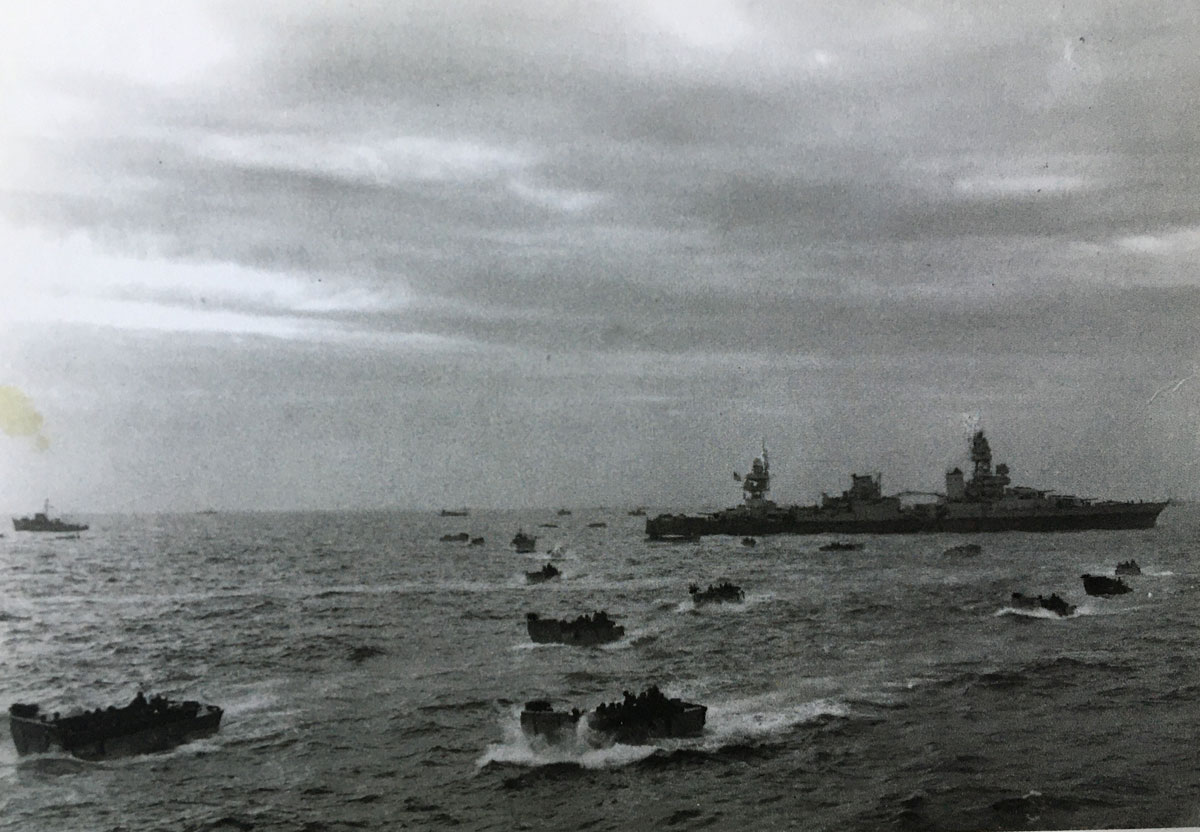 30 ft LCVP (Landing Craft Vehicle Personnel) (Higgins Boats) heading for Omaha Beach on 6 June 1944
In the background is the cruiser USS Augusta, flagship of the Western Naval Task Force
30 ft LCVP (Landing Craft Vehicle Personnel) (Higgins Boats) heading for Omaha Beach on 6 June 1944
In the background is the cruiser USS Augusta, flagship of the Western Naval Task Force
Sixteen months earlier on 13 November 1942 HMS Venomous had berthed alongside the USS Augusta at Casablanca and the USN had fed and clothed the survivors from HMS Hecla
Scanned from a postcard belonging to Les Mortimer
There were two LCT 703. LCT 703
was an American LCT with a USN crew which was sunk on D Day but Les
Mortimer served in HM LCT-703, a British Landing Craft Tank in 57 LCT
Flotilla (known as the 57 'Heinz'), part of Q LCT Squadron (Senior
Officer Lt Cdr Arthur Duncan Stather Dunn) based at Plymouth. QLCT
Squadron operated with B Force, the follow-up force for the
American beaches in the west including Omaha, the most fiercely
defended of the five beaches. He joined HMLCT 703 in September
1943 and "did thirteen landings in the American sector and one in
Arromanches (British sector)". Click on this link to see the
stowage plan for LCT-1097,
an addendum to the orders for Force G (
IWM Documents.9372). This would be
similar to that for LCT 703 and included three cruiser tanks.
Julie Nestic identified her maternal grandfather, Les Mortimer,
in the photographs of the crew of HM LCT-703 below. If you recognise a
family member who served in HM LCT-703 during the Normandy landings
please
e-mail Bill Forster so that he can add his name to the caption
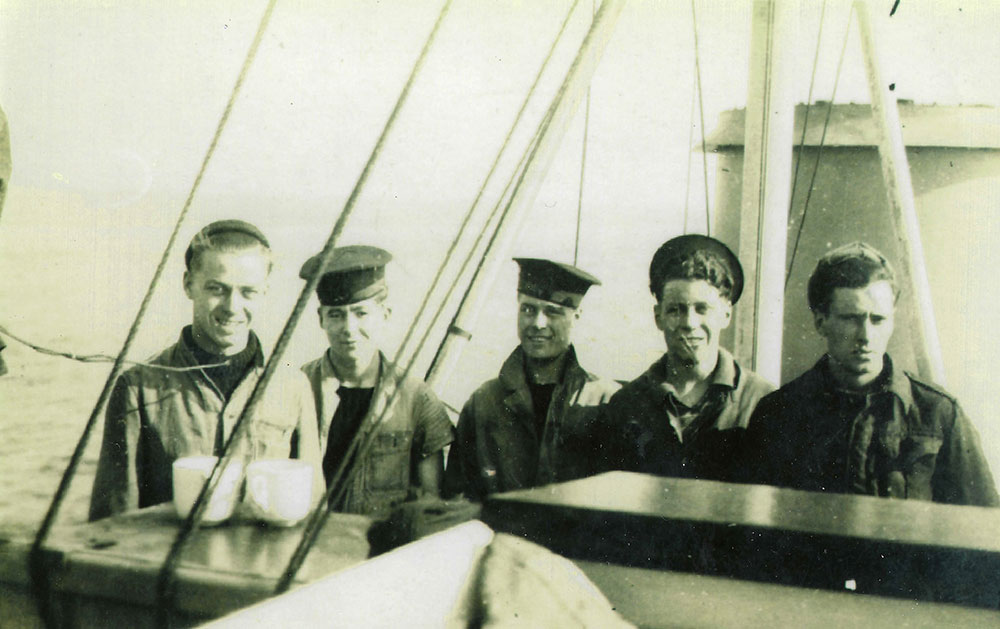
Les Mortimer is second from left in this photograph which may have been
taken during training on another landing craft berfore he joined HM
LCT-703
Taken on the bridge at the stern - note the funnel
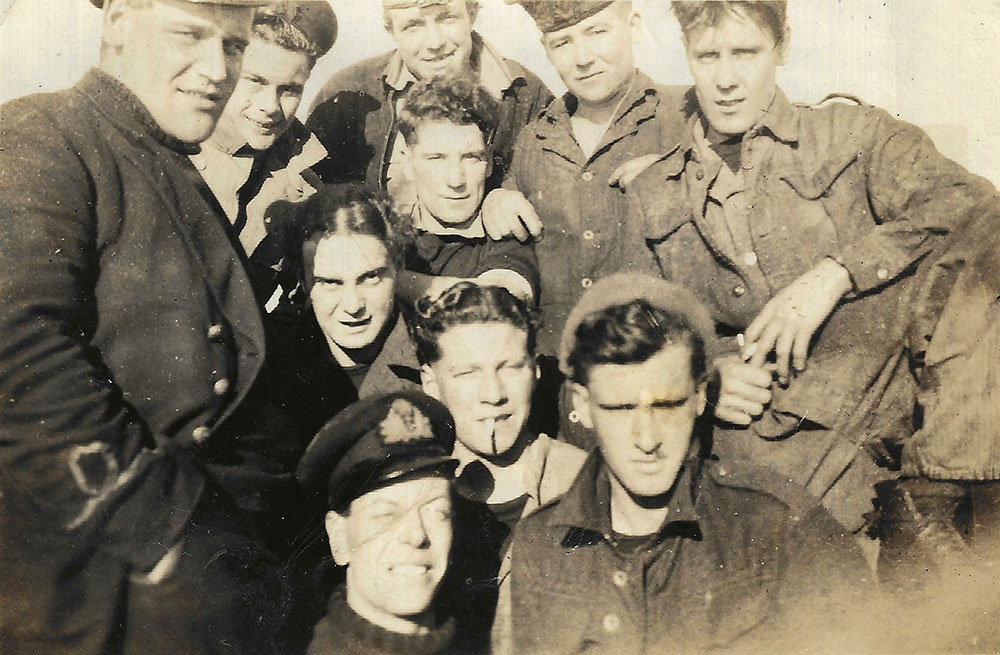
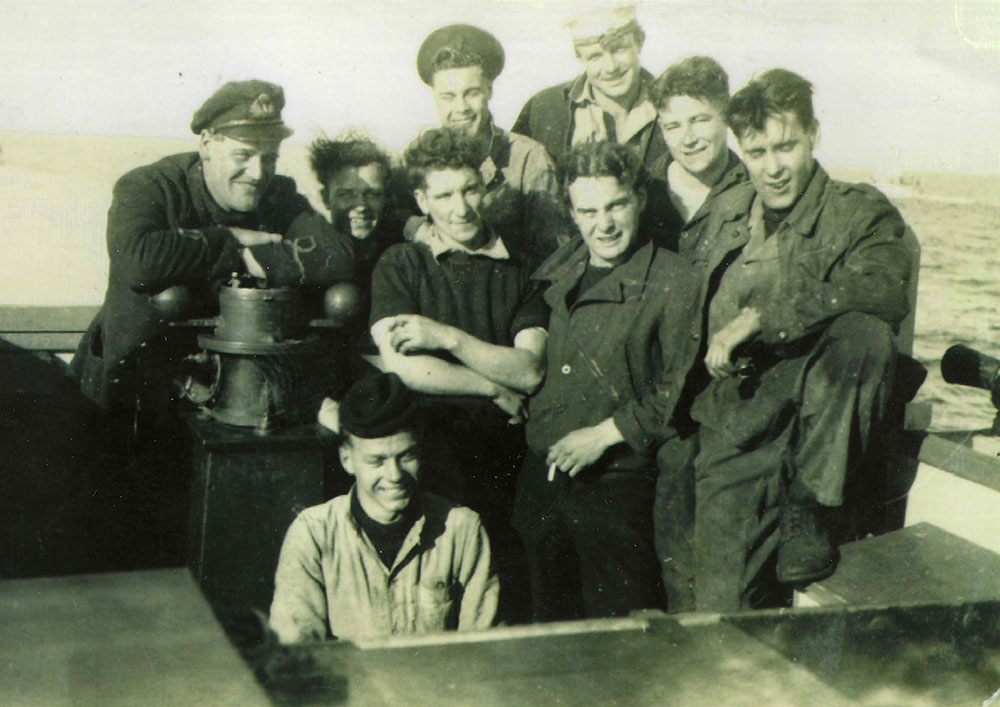 Les Mortimer is second from
right in this photo of LCT 703 on on her way to Normandy on
5 June - but who are the other crew members?
Les Mortimer is second from
right in this photo of LCT 703 on on her way to Normandy on
5 June - but who are the other crew members?
The Sub Lt in the RNVR on the left and many others are in both photos but have not been identified
Bad weather forced the postponement of the D Day Landings to 6 June
Photograph courtesy of Julie Nestic, grand daughter of Leslie Mortimer
I
am hoping to receive more details of this period in Les
Mortimer's life from his family but in the meantime click on the link
to see
the Admiralty Green List (ADM 210) of LCT in Q LCT Squadron (revised
weekly) and read the account of Austin Prosser who joined the Navy as
an Ordinary Seaman in 1942 and by 1944 was First Lieutenant in HM Landing Craft Tank 1171 part of LCT Flotilla 57
which included Les Mortimer's LCT. His irreverent attitude frequently
got him into trouble with authority but makes for an amusing read.
"We
had an extremely rough trip [from Oban] to Plymouth during which we
discovered what a battering our ship could take. Some ships had faired
less well and others had been lost. In Plymouth we learnt that we were
to be attached to the American forces. A near mutiny was threatened
when American senior officers visited our ship to explain the
implications of our attachment to their Navy. There must have been many
important operational matters discussed but amongst it all was a ban on
alcohol to bring us into line with the US Navy 'dry ships' policy. This
immediately captured our attention and there was uproar! After a lot of
discussion, and a few diplomatic moves to keep the peace among the
Allies, it was decided that nothing should change. In the event it was
a popular outcome for everyone since the Americans spent a fair amount
onboard helping us deplete our stocks of drinks in case, as was
expected, we would be on a one-way mission!
More
training and routine maintenance on board followed and we had some
large folding extensions fitted to our bow door to make it easier to
unload vehicles on the beaches. Then the time came for our flotilla,
the 57th (otherwise known as the 57 'Heinz') to take on board our cargo
at St Johns on the south (Cornish) side of the Tamar River. We loaded
six Sherman tanks, six half-track ammunition lorries, two half-track
ambulances and all their crews. Our ship was now rather overcrowded.
At
this late stage we finally found out where we were going and what was
expected of us - we had to deliver our precious cargo onto a beach
codenamed Omaha in Normandy..." click on this link to continue reading Lt Austin Prosser's account.
Prosser's LCT broke in two and sank while returning from Omaha Beach in October.
 The Pennant Numbers of LCT 2313 and LCT 2479 are visible in this photograph taken at Antwerp after the clearing of the Scheldt estuary
The Pennant Numbers of LCT 2313 and LCT 2479 are visible in this photograph taken at Antwerp after the clearing of the Scheldt estuary
Written on reverse by Les Mortimer: - "Two Mark V: loaded with NAAFI goods. Antwerp."
"The Arromanches Mulberry remained open
well into the autumn for although Le Havre and Antwerp were captured
during the first half of September, neither could be reopened until
November, the former because demolition, by the RAF as well as the
retreating Germans, had been so comprehensive and the latter because
the heavily-mined approaches to the undamaged port were dominated by
enemy-held territory, necessitating a further major amphibious
operation (the invasion of Walcheren), followed by a major mine
clearance operation before the first cargo could be delivered. Antwerp's docks were the largest in Europe with a daily
capacity of 40,000 tons and were opened to large ships on 28 November 1944 and, thereafter became the principal Allied supply
port for the advance into Germany."
Operation Neptune: The Normandy Invasion, D-Day 6 June 1944 (Naval Historical Branch).
The
Clearing of the Scheldt Estuary and the Liberation of Walcheren
between 2 October – 7 November 1944 which opened up Antwerp’s port to Allied
shipping is described in a commemorative booklet pubished by the COI for the Ministry of Defence on the
60th anniversary of the end of the war which can be read online as a
PDF by clicking on the link.
***************
Emigration to Australia
After the war Les Mortimer returned to Britain and worked at Austin
Motors' Longbridge plant at Oxford before
marrying and emigrating
to Australia:
"he
married Edna Nash (my beautiful grandmother) on 12 Feb 1946 at Kings Norton Church
Birmingham and was released from the Navy four months later on 31 May
1946. He moved to Australia in 1949 after my mother, Janet Mortimer,
was born in
1947" (Julie Nestic, his Grand-daughter).
In 1998 when Les wrote the account of his rescue from HMS Hecla he was living in an outlying district of Melbourne near where his children and grand children lived. Leslie Mortimer was 92 when he died in 2016.
A second daughter, Carol Tregonning (nee Mortimer), was born in Australia and is alive today:
"Dad
was a very quiet man and pretty private about his tragic experiences.
He suffered from bouts of manic depression all his adult life and I’m
sure the hardships that he went through contributed to this. Dad's
funeral was on 11. 11. 2016. It wasn’t planned for that date. Just a
date I chose at random. Only after did we realise that it was the
anniversary of the sinking. A very strange occurrence. Mother told me
she received a telegram informing her that Dad had died in action. He
later turned up on her doorstep. That must have been a big shock for my
Mother."
Sadly, Carol has no contact with his family in England and I am hoping that they will read his story here and get in touch with me by e-mail
The Last Man Standing?
There were 858 officers and men aboard Hecla
when she was torpedoed and 282 names on the list issued by the
Admiralty of those who died. I have traced the families of less than a
hundred and non of them are alive today but the publicity the death of
Reg Bishop on 4 June 2022 received in national newspapers (The Sun, Express and Mirror
on 17th June and the Daily Mail online 17th June) may lead to me being
contacted by the family of an elderly survivor before this year's 80th
anniversary of the loss of HMS Hecla on 11 November 2022, Armistice Day.







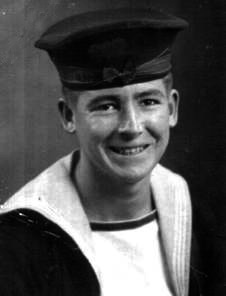
 Leslie
Mortimer was one of eleven children of Rowland Mortimer, a mattress
maker, and his wife Emily May (nee Flynn). He was born at Kings Norton,
Birmingham, on the 24 November 1923
and trained as a bench fitter (drilling machine operative). He gave his
mother as his nearest relative when he enlisted in the Royal Navy aged
eighteen in December 1941.
Leslie
Mortimer was one of eleven children of Rowland Mortimer, a mattress
maker, and his wife Emily May (nee Flynn). He was born at Kings Norton,
Birmingham, on the 24 November 1923
and trained as a bench fitter (drilling machine operative). He gave his
mother as his nearest relative when he enlisted in the Royal Navy aged
eighteen in December 1941. 

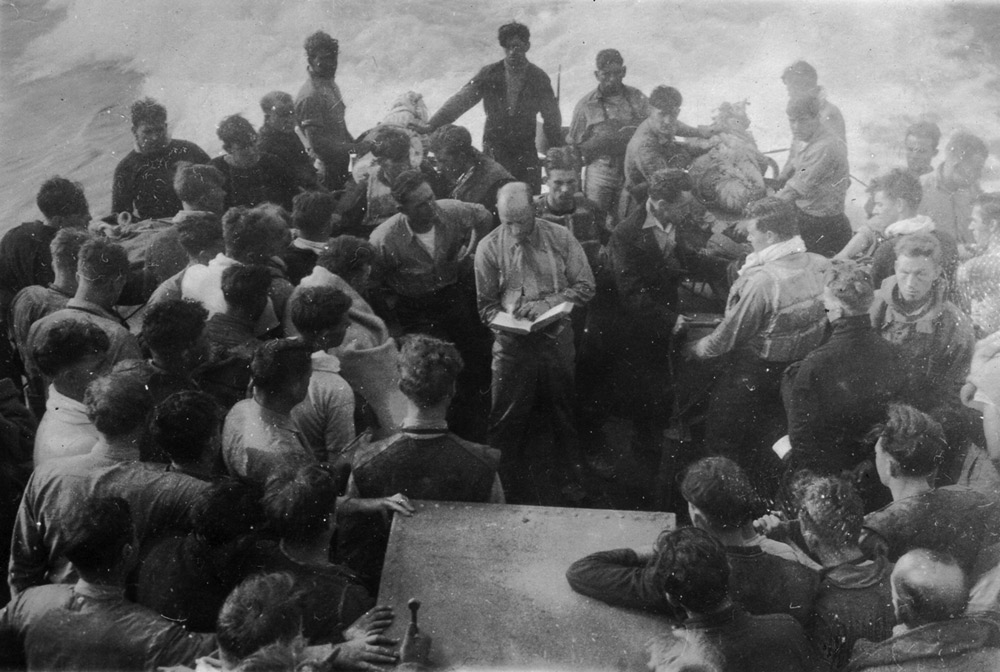
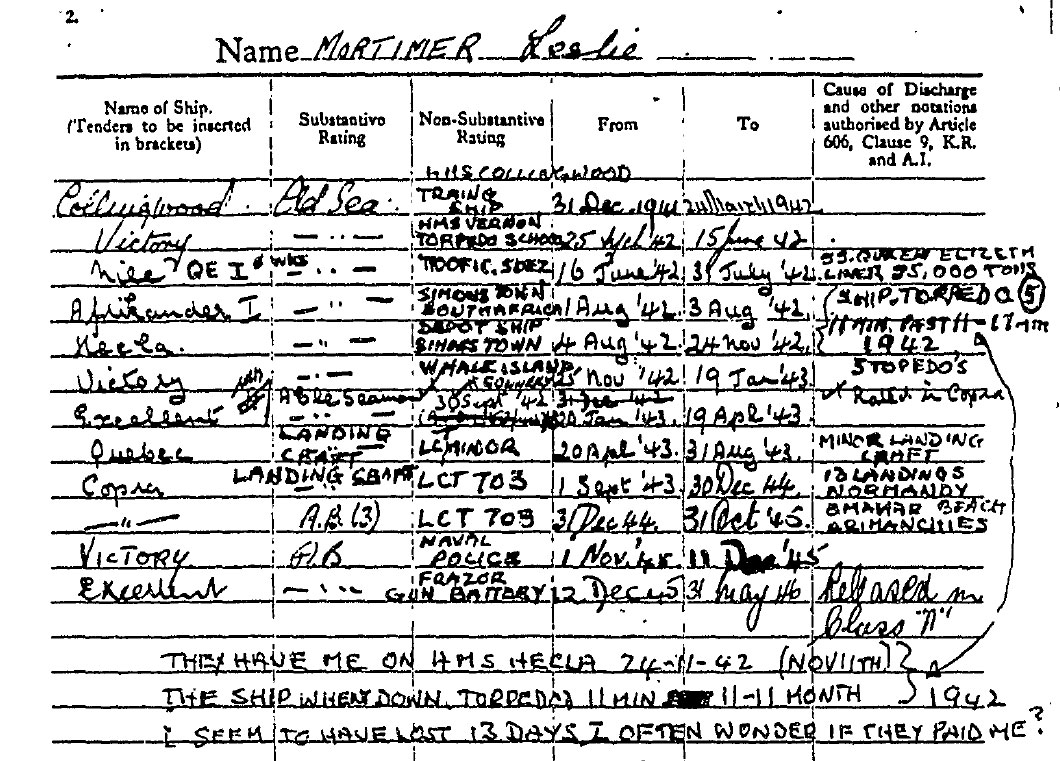





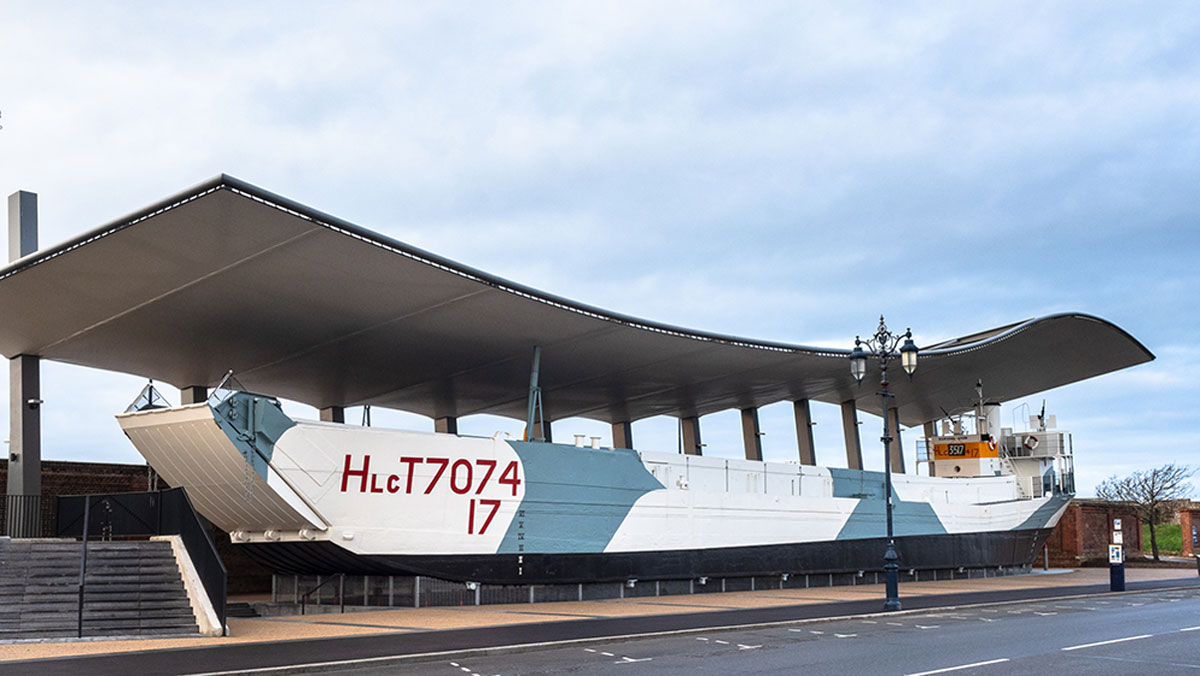
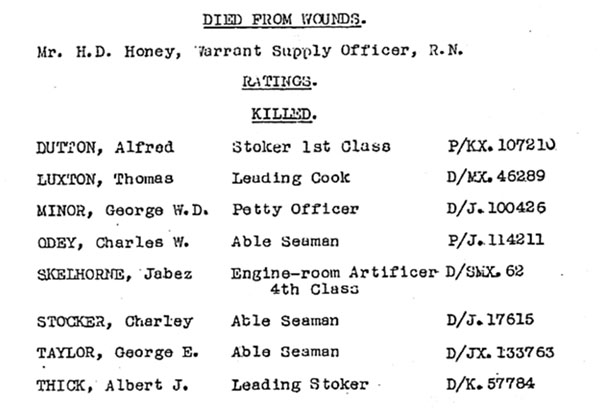
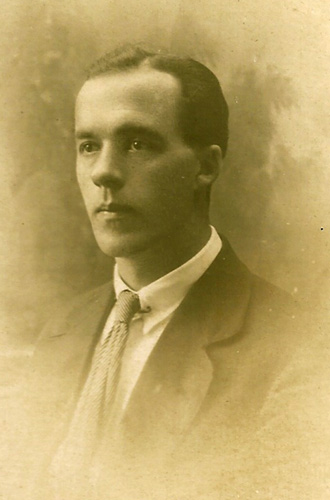
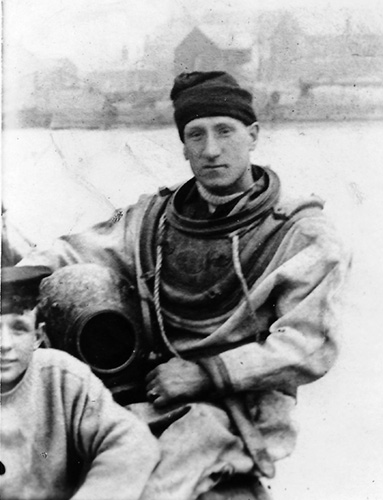 Charley - not Charles -
Stocker was born at Uplyme near Lyme Regis on the Devon Dorset border
on the 28th June 1896 and was probably the oldest rating in Hecla when she was torpedoed. He left school at 14 and went into domestic service at the nearby village of Whitchurch Canonicorum.
Charley - not Charles -
Stocker was born at Uplyme near Lyme Regis on the Devon Dorset border
on the 28th June 1896 and was probably the oldest rating in Hecla when she was torpedoed. He left school at 14 and went into domestic service at the nearby village of Whitchurch Canonicorum.